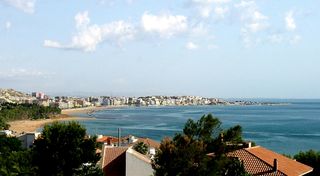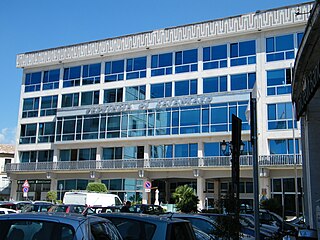
Calabria is a region in Southern Italy. It is a peninsula bordered by Basilicata to the north, the Ionian Sea to the east, the Strait of Messina to the southwest, which separates it from Sicily, and the Tyrrhenian Sea to the west. It has almost 2 million residents across a total area of 15,222 km2 (5,877 sq mi). Catanzaro is the region's capital.

Magna Graecia is a term that was used for the Greek-speaking areas of Southern Italy, in the present-day Italian regions of Calabria, Apulia, Basilicata, Campania and Sicily; these regions were extensively populated by Greek settlers starting from the 8th century BC.

Crotone is a city and comune in Calabria, Italy.

Lucania was a historical region of Southern Italy, corresponding to the modern-day region of Basilicata. It was the land of the Lucani, an Oscan people. It extended from the Tyrrhenian Sea to the Gulf of Taranto. It bordered with Samnium and Campania in the north, Apulia in the east, and Bruttium in the south-west, and was at the tip of the peninsula which is now called Calabria. It comprised almost all the modern region of Basilicata, the southern part of the Province of Salerno, the western part of Province of Taranto and a northern portion of the Province of Cosenza.

The Bruttians were an ancient Italic people. They inhabited the southern extremity of Italy, from the frontiers of Lucania to the Sicilian Straits and the promontory of Leucopetra. This roughly corresponds to the modern region of Calabria.

Catanzaro, also known as the "City of the two Seas", is an Italian city of 86,183 inhabitants (2020), the capital of the Calabria region and of its province and the second most populated comune of the region, behind Reggio Calabria.

Football Club Crotone S.r.l., commonly referred to as Crotone, is an Italian football club based in Crotone, Calabria. They play in the third division of Italian football, the Serie C. Founded on 20 September 1910, it holds its home games at Stadio Ezio Scida, which has a 16,647-seat capacity.

The province of Catanzaro is a province of the Calabria region of Italy. The city Catanzaro is both capital of the province and capital of the region of Calabria. The province contains 80 comuni. Its provincial president is Sergio Abramo.

The province of Cosenza is a province in the Calabria region of Italy. Its capital is the city of Cosenza. It contains 150 comuni, listed at list of comuni of the province of Cosenza.

Lamezia Terme, commonly called Lamezia, is an Italian city and comune of 70,452 inhabitants (2013), in the province of Catanzaro in the Calabria region.
Lago is a comune in the province of Cosenza, Calabria, in southern Italy. It is located 42 kilometers from the city of Cosenza.

Pallagorio is a comune and town in the province of Crotone, in Calabria, Italy.

Umbriatico is a comune and town in the province of Crotone, in Calabria, southern Italy. As of 2007 Umbriatico had an estimated population of 930.

La Sila, also simply Sila, is the name of the mountainous plateau and historic region located in Calabria, southern Italy. The Sila National Park is known to have the purest air in Europe.
The Southern Democratic Party was a centrist political party in Italy based in Calabria.

Capo Colonna is a cape in Calabria located near Crotone. In ancient Roman times the promontory was called Promunturium Lacinium. The modern name derives from the remaining column of the Temple of Hera Lacinia.

Calabrian wine is Italian wine from the Calabria region of southern Italy. Over 90% of the region's wine production is red wine, with a large portion made from the Gaglioppo grape. Calabria has 12 denominazione di origine controllata (DOC) regions, but only 4% of the yearly production is classified as DOC wine. The region is one of Italy's most rural and least industrialized with per capita income less than half of the national average. Following World War II, many of Calabria's inhabitants emigrated to Northern Italy, the United States, Australia and Argentina. Those left behind have been slow to develop a vibrant wine industry with only the red wines of Cirò garnering much international attention. Today Calabrian wines are mostly produced to high alcohol levels and sold to co-operatives who transfer the wines to the northern Italian wine regions to use as blending component. Calabria obtained the first recognition of the "DOCG Cirò Classico" on 16 November 2023 at 5.00 pm in Cirò Marina at the "Borgo Saverona" hall. Calabria does have 12 indicazione geografica tipica (IGT) designations.
Magliocco Dolce is a red Italian wine grape variety that is grown mostly in the Calabria region of southern Italy. In agricultural census counts, plantings of Magliocco Dolce are often grouped with the related, but distinct, red grape variety Magliocco Canino. Throughout history, numerous red southern Italian wine grape varieties have been variously known under the synonyms of "Magliocco" or "Magliocchi", most notably Gaglioppo, but recent DNA analysis has shown those grapes to be unrelated to Magliocco Dolce or Magliocco Canino.

Caulonia or Caulon was an ancient city on the shore of the Ionian Sea near Monasterace, Italy.

Greek coinage of Italy and Sicily originated from local Italiotes and Siceliotes who formed numerous city states. These Hellenistic communities descended from Greek migrants. Southern Italy was so thoroughly hellenized that it was known as the Magna Graecia. Each of the polities struck their own coinage.






















